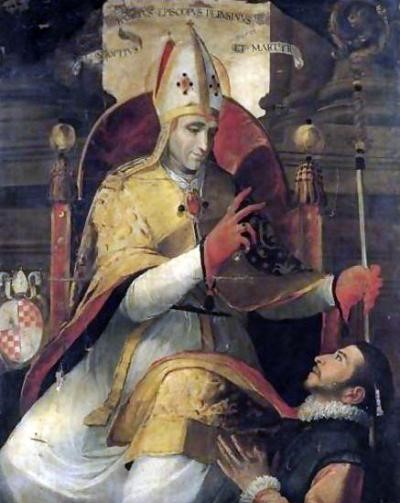
Saint of the Day for 29 January: St. Constant of Perugia
St. Constant of Perugia: History and Worship of the Patron Protector of the Umbrian City
Name
St. Constant of Perugia
Title
Bishop and martyr
Birth
2nd century, Perugia
Death
2nd century, Perugia
Recurrence
29 January
Martyrology
2004 edition
Prayer
Hail, Constantius martyr glory of Holy Umbria
We unanimously proclaim Thee our garrison and boast.
Father and vigilant shepherd turn your loving gaze
On thy faithful supplicants full of holy ardor.
Glory to the Almighty to the Son and the Paraclete
Whose merit the Martyr came to eternal honor.
Amen
Pray for us Saint Constantius the Martyr that we may be made worthy of the promises of Christ
Patron of
Perugia, Nave, Pisogne, Torrita di Siena, San Costanzo, Vignolo, Castelpoto, Montorio nei Frentani
Roman Martyrology
In Perugia Saint Constantius, Bishop and Martyr, who, together with Companions, under Emperor Marcus Aurelius, for the defense of the faith received the crown of martyrdom.
The Saint and Mission
Saint Constantius of Perugia, revered as one of the patron saints of the Umbrian city, represents a significant figure reflecting a mission of faith and endurance in times of trial. His story, though shrouded in the mists of legend and tradition, speaks of an unwavering commitment to the Christian faith during a time of persecution. St. Constans’ mission can be seen as an example of spiritual courage and fidelity to his principles. At a time when professing the Christian faith could lead to severe consequences, his determination to stand firm in his faith became a powerful message of endurance and hope. This commitment was not only about his personal devotion, but also about his desire to sustain and inspire his community through dark times. The story of St. Constans reminds us that the mission of a saint is not only about works and preaching, but also about presence and example. His figure, which has become an integral part of Perugia’s cultural and spiritual fabric, shows how the memory of an individual can continue to influence and empower an entire community long after his physical death. St. Constans, then, is a symbol of the resilience of faith and the ability to withstand adversity while holding firm to one’s convictions. His legacy invites us to reflect on the inner strength that flows from faith and the importance of being witnesses of that faith in the world, regardless of the challenges we may face.
The Saint and Mercy
St. Constantius of Perugia, as a historical and spiritual figure, is deeply intertwined with the concept of mercy, a fundamental pillar in Christian life. Although the specific details of his life may be shrouded in legend, the essence of his story and cult reveals a deep connection with both divine and human mercy. As the patron saint of Perugia, St. Constantius is celebrated not only for his martyrdom but also for his role as a spiritual guide and protector. His figure has become a symbol of refuge and hope for the community, embodying God’s mercy toward his people. This aspect of mercy goes beyond mere compassion; it is an act of protection, love and unconditional support. In the context of the persecutions the early Christians faced, the story of St. Constans also speaks of a mercy extended to others, particularly those who suffered for their faith. His dedication and sacrifice can be seen as a supreme act of mercy, putting the needs and spiritual well-being of his community above his own life. St. Constans teaches us that mercy is not only an emotional response to the suffering of others, but also an active commitment to justice, truth and the protection of the defenseless. His legacy is an invitation to reflect on the deeper meaning of mercy and its transformative power, not only in the lives of individuals, but also in the community as a whole. His life and worship remind us that being merciful is one of the highest expressions of faith and humanity.
Hagiography
Constantius lived in the second century and was a young Christian who distinguished himself early on in the Perugian Church by his zeal and generosity toward the poor combined with great severity toward himself. He was therefore elected bishop very young, when he was just 30 years old. He was, however, already prudent, wise in the apostolate, mature in charity, firm in authority, and…
